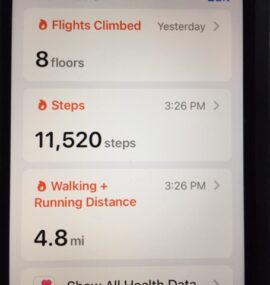Is 10,000 the magic number?
Maybe not magic, but 10,000 daily steps can improve your health
Accelerometers are small, simple, inexpensive devices that capture data to calculate the number of daily steps. While accelerometers are relatively new in America, they’ve been used in Japan since the 1960s. Japanese widely embrace a goal of 10,000 steps per day, which has become popular in America. This number of steps is equivalent to 300 – 400 calories of energy expended depending on walking speed and body weight. Two researchers proposed the following classification of physical activity in healthy adults in terms of steps per day: sedentary is less than 5,000; low active is between 5,000 and 7,500; somewhat active is between 7,500 and 10,000; active is between 10,000 and 12,500; and highly active is more 12,500.
Many Americans have a daily goal of 10,000 steps to promote better health. Five published studies indicated, however, that achieving this number of steps is the exception rather than the rule for most Americans. The average daily deficit over the five studies was about 4,000 steps. Meeting the 10,000 daily step goal will require most people to make physical activity a bigger part of their daily lives.
Would getting 10,000 steps per day reduce cardiovascular disease risk factors related to overweight and obesity? The Household Budget Survey 2008 – 2009 in Brazil showed that 50 percent of adult men were overweight and 12 percent were obese. Brazilian researchers used accelerometers to study the walking habits of 299 men between ages 40 and 59 who worked in various office jobs at the Federal University of Vicosa. The results showed a dose-response relationship between the number of steps walked and cardiovascular risk factors. Subjects who walked more than 10,000 steps per day had lower body-mass index, less abdominal fat, and better blood chemistry (lower insulin and triglycerides). Evidently healthy middle-aged Brazilian men who walked more than 10,000 steps per day exhibited better cardiovascular condition and less evidence of the metabolic syndrome that men who didn’t walk that much.
Would 10,000 daily steps predict lower mortality rates among older women? Researchers used accelerometer-measured daily step data over 7 days from a cohort of 16,741 women (average age 72 years) in the Women’s Health Study to find out. During a follow-up of 4.3 years and compared with the least active women (about 2,700 steps per day), women who averaged about 4,400 steps per day had significantly lower all-cause mortality rates. More specifically, as the median number of steps increased from 2,718 to 4,363 to 5,905 to 8,442, the adjusted risks of all-cause mortality declined by 41, 46, and 58 percent, respectively. The reduced mortality benefit plateaued at about 7,500 steps per day. Higher step intensity did not predict lower mortality rates after accounting for total steps per day. The clear message for older women: Start walking with a goal of 7,500 steps per day!
Frailty refers to a progressive decline of bodily function with advancing age. Increased physical activity predicts lower risk of mortality and certain chronic diseases (hypertension, type 2 diabetes, cardiovascular disease). Yet, the link between physical activity and frailty has received little scientific attention. Researchers in Japan used data from 3,616 participants (average age 72 years) in the Kyoto-Kameoka Study to determine if higher step counts predicted lower prevalence of frailty. Step counts measured with accelerometers over 4-10 days were grouped in quartiles of 1) 1,759, 2) 2,988, 3) 4,377, and 4) 7,200 steps per day on average.
Compared to the lowest quartile, participants in the highest quartile of daily steps had significantly lower risks of hypertension, heart disease, and excessive blood fats. Using the Fried definition of frailty and compared to participants in the lowest quartile of daily steps, participants in the highest quartile had a significant 59 percent lower likelihood of being frail. Using the Kihon checklist to define frailty, the comparable result was a significant 48 percent lower likelihood of being frail. Both results reflected adjusting for confounding effects, including chronic diseases.
Each 1,000-step increment increase in daily step count (about 10 minutes of brisk walking) predicted significant 26 and 15 percent lower likelihoods of being frail for participants with fewer and greater than 4,000 steps per day, respectively. Even participants in the second quartile of daily steps had significantly lower likelihood of being frail compared to participants in the lowest quartile. The prevalence of frailty declined up to 14,000 steps per day. Want to reduce your risk of becoming frail in your later years? Keep Moving and take more each day. Even modest increases in daily steps may help you avoid frailty.
American popular culture promotes taking 10,000 steps per day for better health, but most evidence to support 10,000 steps comes from studies of older people. A new report included 2,100 middle-aged participants in the Coronary Artery Risk Development in Young Adults (CARDIA) study. The number of daily steps measured with accelerometers was categorized as low (less than 7,000 per day), medium (between 7,000 and 9,999), and high (10,000 or more). Compared to participants in the lowest category of daily steps and after accounting for numerous confounding factors, participants in the highest category had a 55 percent lower risk of dying over11 years of follow-up. More than about 10,000 steps per day did not predict further reduced risk of dying. Interestingly, the earlier study of older women (average age 72 years) found that mortality risk plateaued above about 7,500 steps per day. Perhaps younger people need more daily steps than older people. Still another study found that participants with 4,000 steps per day had a 30 percent lower risk of dying during follow-up compared to participants with 2,000 steps per day. Will the current research motivate you to set a goal of 10,000 steps per day? If so, you may live longer and better.








